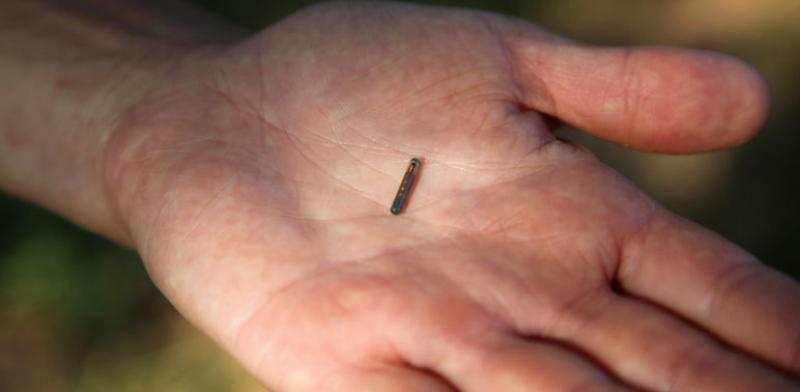Salmon runs are threatened or endangered throughout much of the Pacific Northwest, and scientists have been working for decades to bring them back from the brink. That can involve removing dams or adding fish passages to them, rehabilitating streams, and reducing sedimentation. Whatever strategy they use, scientists need to keep track of salmon—where and when they’re migrating, and how many survive each stage of their lifecycle. That’s the only way to measure how well restoration strategies are working.
Scientists have several tools to choose from for keeping track of fish, but one of the simplest and most effective is a tiny device called a Passive Integrated Transponder, or PIT tag.
NOAA biologist Earl Prentice first heard about this technology in the early 1980s, when a story came on the radio about a Colorado rancher with a startup business selling PIT tags for livestock. Instead of branding cattle the old-fashioned way, ranchers could insert a tag beneath the skin, and a computer would log the animal’s whereabouts when it walked within range of an antenna.
"It was exactly what we needed in the river," Prentice said. But implanting a horse tag into a salmon smolt fresh out of the hatchery would have been impossible. "The tags were bigger than the fish!" Prentice said.
Prentice and his colleagues, along with partners in private industry, would spend most of the next decade miniaturizing the tags and devising a way to inject them harmlessly into juvenile fish smaller than the width of your palm. Their success revolutionized fisheries science and sparked a whole new sector of start-up businesses focused on further refining the technology.
Monitoring the Passage of Fish in Real Time
PIT tags work like the automatic toll-paying devices motorists attach to their windshields. Scientists inject the tag into juvenile fish using a syringe, and then install antennas at narrow points along the river that function like tollbooths. The reading antenna supplies the power, so the battery-free tags last the animal’s lifetime.
Previously, scientists relied on tiny tags stamped with batch codes that could be read under a microscope. Those simple and inexpensive tags are still in use today. But because you have to catch the fish to extract the tag, using them is labor-intensive for the scientists—and deadly for the fish. "With PIT tags, it's as if each fish has its own social security number, and you don't have to handle the fish to know what it is," Prentice said.
Not having to handle the animal more than once is particularly important when working with endangered species, where injuring or sacrificing even a single individual would be ill-advised.
What’s more, PIT tags identify each fish individually rather than by batch. This gives scientists great statistical power. "If you give them a disease treatment or change their diet, you can see how well those fish survive,” Prentice said. You can also monitor their progress on a computer screen, following them not only as they make their way to the ocean, but also when they return as adults.
A Collaborative Effort
Initial funding for the research came from NOAA Fisheries and the Bonneville Power Administration. The U.S. Army Corps of Engineers and the Bureau of Reclamation, which operate the dams, have also been involved. Dam operators send water through spillways so that juvenile salmon can avoid hazardous turbines during their migration downriver. Thanks to PIT tags, operators can see when a pulse of salmon are coming their way and open the spillways to allow safe passage.
PIT tags continue to provide data years later, when the fish return to spawn. “You can track the survival of returning adults as they migrate upriver,” said Des Maynard, a NOAA Fisheries biologist who worked on PIT tags in the early days. “That helps us identify reaches with reduced migratory success and focus habitat restoration where it would provide the greatest benefit.”
Like many new technologies, PIT tags have stimulated economic activity and created jobs, with private companies building everything from the tiny tags themselves to antennas that span entire streams.
The Places They Go
PIT tags move through the ecosystem in unexpected ways. Seabird scientists can be spotted in bird colonies waving portable antennas over the sand like treasure hunters with metal detectors. They do that to locate PIT tags that birds poop out after eating a tagged fish. This helps scientists understand what the birds are preying on and where. One tag from the Columbia River was recovered in New Zealand, an apparent stowaway on a very long flight.
In the 25 years since PIT tags became a standard tool for fish biologists, more than 35 million fish have been tagged in the Columbia River Basin alone. The worldwide number is surely many times as large. They’ve also been used to study the migrations of everything from sea turtles to wildebeest.
Today, radio frequency ID tags, which are based on a similar technology, are used to track pets and monitor product shipments. They’re even used on assembly lines to track components as they come together on the factory floor. Like many revolutionary innovations, they seem obvious in retrospect. But in 1981, when Earl Prentice first held a horse tag in his hand, it was far from obvious that the tags would work in tiny fish.
“It was a real gamble,” Prentice said, speaking of the years that he and others spent miniaturizing the tags before they proved useful. “Once in a while you win one.”


